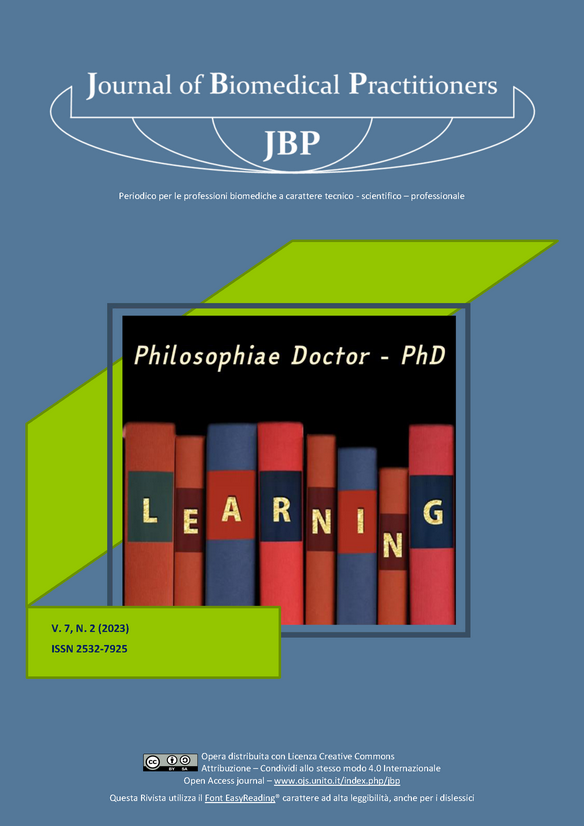The Ross classification as a tool for nursing evaluation in pediatric patient with heart disease.
Contenuto principale dell'articolo
Abstract
Background
Heart failure is a clinical syndrome following myocardial dysfunction with inadequate response to the body's metabolic demands. It appears more critical and complex in children than in adults. It is essential to treat this condition early: for this reason, the Ross classification was developed, which assigns a score to the patient based on the presented signs and symptoms.
Aims
The primary aim was to evaluate whether the data (signs, symptoms and behaviors of the child) collected non-invasively by the nurse were predictive of the risk of heart failure according to the Ross Classification in a cohort of pediatric patients after cardiac surgery for correction of atrial septal defect (ASD) or ventricular septal defect (VSD). The secondary aim was to correlate the trend of the scores obtained from the classification with variables such as hospitalization time (in days) and number of rehospitalizations.
Methods
Retrospective observational study conducted on a sample of medical and nursing records of patients between 0 and 18 years hospitalized at the Congenital Pediatric Cardiology and Heart Surgery - Pediatric Intensive Care Unit of Azienda Ospedaliero Universitaria delle Marche in 2021. A score was assigned according to the Ross Classification to each patient. A statistical analysis followed using Wizard and STATA software.
Results
Most of the patients belonged to the second class of Ross (51%), while none presented parameters included in the fourth class. It emerged that patients included in the second and third classes of Ross had a longer hospital stay than those who were included in the first class as well as a greater relative risk of total hospital stay. Hospitalizations involved 5% of the sample (3/57).
Conclusions
Nurse is fundamental in the detection of the parameters for the computation of the Ross classification in heart failure in pediatrics. In addition to the clinical-instrumental data, observation during feeding and the severity of the related respiratory distress is fundamental.
The creation of a multidisciplinary team that addresses every aspect related to heart failure allows an effective comparison between different health professionals and an excellent level of assistance.
Downloads
Dettagli dell'articolo
Gli autori mantengono i diritti sulla loro opera e cedono alla rivista il diritto di prima pubblicazione dell'opera, contemporaneamente licenziata sotto una Licenza Creative Commons - Attribuzione che permette ad altri di condividere l'opera indicando la paternità intellettuale e la prima pubblicazione su questa rivista.
Riferimenti bibliografici
[2] SANDRI A. (1950) L'uso dei fattori lipotropi nella terapia dell'insufficenza cardiaca cronica [Use of lipotropic factors in the therapy of chronic cardiac insufficiency]. Arcisp S Anna Ferrara,3(4), 371-397.
[3] Braunwald E. (1997). Shattuck lecture--cardiovascular medicine at the turn of the millennium: triumphs, con-cerns, and opportunities. The New England journal of medicine, 337(19), 1360–1369. https://doi.org/10.1056/NEJM199711063371906.
[4] Bierer, J., Stanzel, R., Henderson, M., Sett, S., & Horne, D. (2019). Ultrafiltration in Pediatric Cardiac Surgery Review. World journal for pediatric & congenital heart surgery, 10(6), 778–788. https://doi.org/10.1177/2150135119870176.
[5] Artman, M., Mahony, L., Teitel, D. (2011) Neonatal cardiology. NY: The McGraw-Hill Companies; Second edition.
[6] Ross, R. D., Daniels, S. R., Schwartz, D. C., Hannon, D. W., Shukla, R., & Kaplan, S. (1987). Plasma norepineph-rine levels in infants and children with congestive heart failure. The American journal of cardiology, 59(8), 911–914. https://doi.org/10.1016/0002-9149(87)91118-0.
[7] Ross R. D. (2012). The Ross classification for heart failure in children after 25 years: a review and an age-stratified revision. Pediatric cardiology, 33(8), 1295–1300. https://doi.org/10.1007/s00246-012-0306-8.
[8] Do Nascimento, A. D. N., Testa, O., Ricotti, A., Bagnato, S., & Ghironi, E. (2021). Workplace well-being of Ad-vanced Practice Nurses and patient outcomes. Professioni infermieristiche, 74(4), 264. https://doi.org/10.7429/pi.2021.744264b.
[9] Di Tano, G., Di Lenarda, A. (2022). Rapidità, simultaneità, sinergia e personalizzazione nella terapia iniziale del-lo scompenso cardiaco con frazione di eiezione ridotta: quattro regole per i quattro farmaci raccomandati [Speed, simultaneity, synergy and personalization in the first-line therapy for heart failure with reduced ejection fraction: four rules for the four recommended drugs]. G Ital Cardiol (Rome),23(9),663-667. doi:10.1714/3860.38448.
[10] Gori, M., Tinti, M.D., Gentile, P., et al. (2022). Lo scompenso cardiaco con frazione di eiezione migliorata: indi-cazioni gestionali per il clinico [Heart failure with improved ejection fraction: practical guidance for the clini-cian]. G Ital Cardiol (Rome),23(12),924-931. doi:10.1714/3913.38959.
[11] Marsh, K. M., Fleming, M. A., 2nd, Turrentine, F. E., Levin, D. E., Gander, J. W., Keim-Malpass, J., & Jones, R. S. (2022). Pediatric surgical errors: A systematic scoping review. Journal of pediatric surgery, 57(4), 616–621. https://doi.org/10.1016/j.jpedsurg.2021.07.019

